Kristine Hughes's Blog, page 129
March 27, 2012
The Thames Diamond Jubilee Pageant
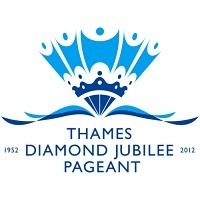 Victoria here, reporting on several favorite topics all at once: the Queen, the Diamond Jubilee, watercraft, and music...based on the latest issue of BBC Music, one of the magazines I try to read each month. In the March 2012 issue, The Full Score reports on the line-up for the Thames Pageant, the ten official musical barges which will parade downstream from Hammersmith to Greenwich on June 3, 2012. How I wish I could be there!! For more on the Pageant, click here.
Victoria here, reporting on several favorite topics all at once: the Queen, the Diamond Jubilee, watercraft, and music...based on the latest issue of BBC Music, one of the magazines I try to read each month. In the March 2012 issue, The Full Score reports on the line-up for the Thames Pageant, the ten official musical barges which will parade downstream from Hammersmith to Greenwich on June 3, 2012. How I wish I could be there!! For more on the Pageant, click here. 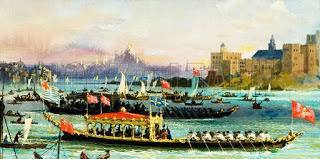 A long-ago royal barge
A long-ago royal bargeIn the first of the musical barges, the Royal Jubilee Bells will announce the parade, in the midst of a thousand other vessels authorized to be on the river that day. It is reported that more than 2,000 applications to join the eclectic fleet -- from kayaks to yachts -- had to be turned down to preserve some sort of traffic flow on the river.
Barge Two will carry the musicians of the Academy of Ancient Music performing Handel's Water Music, composed in 1717 for a river procession honoring King George I. The familiar music is a favorite of concert-goers worldwide.
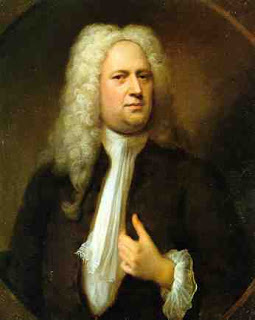 Handel in 1733, by Balthasar Denneer (1685–1749)
Handel in 1733, by Balthasar Denneer (1685–1749)George Frideric Handel (1685-1759) was born in Germany and trained under continental masters in Germany and Italy. He came to London in 1712 and composed dozens of pieces for orchestra, many operas and oratorios, most famously The Messiah, first performed in 1742.
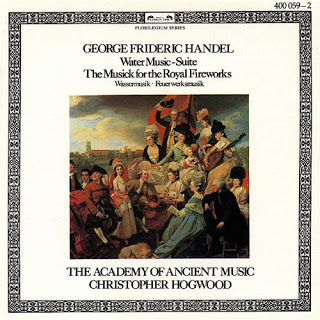 Water Music CD from the AAM
Water Music CD from the AAMHandel's Suites of Water Music were first performed on a Thames barge for the entertainment of George I and his guests. The music was so enthusiastically received that the musicians played them over and over until well into the wee hours. The AAM will also perform selections from the Royal Fireworks Suite by Handel, composed for George II in 1749, performed as fireworks and illuminations lit up the Thames near the Duke of Richmond's.
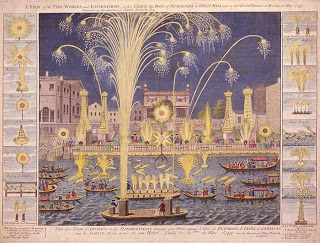
Barge #3 will carry the Herald Fanfare Trumpeters and on #4, the Band of Her Majesty's Royal Marines will hold forth, heading a group of small vessels which took part in the Dunkirk Evacuation in 1940.
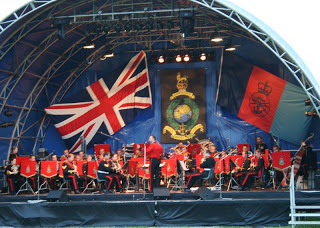 Her Majesty's Royal Marine Band in a dry land performance
Her Majesty's Royal Marine Band in a dry land performanceThe Jubilant Commonwealth Choir will be on Barge #5, followed by the Shree Muktajeevan Pipe Band and Dhoul Ensemble on #6. This group sounds quite fascinating. For more information, click here.
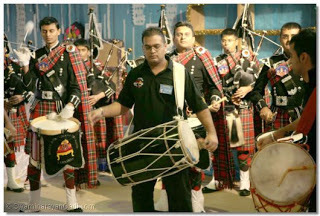 Shree Muktajeevan Pipe Band and Dhoul Ensemble
Shree Muktajeevan Pipe Band and Dhoul EnsembleBarge #7 will bring an ensemble playing new music created for the occasion by ten prominent UK composers, each taking as inspiration a movement from Handel's Water Music.
The Mayor's Junior Jubilee Brass Band will perform on Barge #8. Still to be determined is Barge #9.
On the final musical barge, #10, the London Philharmonic Orchestra will perform favorites from the Proms.
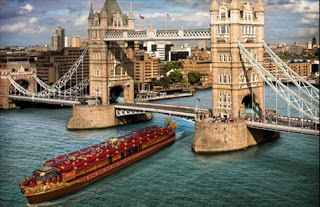 The new royal barge
The new royal bargeSince I will not be in London (boo-hoo) for the great event, I am hoping that arrangements have been made to capture the flotilla on the Thames for the rest of us -- on a DVD. [Or could we suggest to BBC America that they take a day off from that predictable cursing chef and the Top Gear nutcases and Dr. No (how many times???) to bring us something we really want to see on June 3? I fear it is too much to hope for. Nevertheless, I will keep my fingers crossed.]
For more pictures and all the details, check out the Daily Mail's article, here.
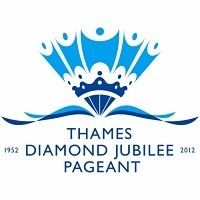 [image error]
[image error]
Published on March 27, 2012 01:00
March 25, 2012
Tom Sully, Artist Extraordinaire
On March 11, 2012, Jo Manning wrote here of her experiences associated with the current exhibition The Look of Love at the Birmingham (AL) Museum of Art, for which she wrote selections in the catalogue. She rhapsodized about the talent and charm of Tom Sully, a contemporary artist who has painted several types of miniatures: portraits, eyes, and pets, as well as accomplishments in many other formats. We wanted to know more about him; what follows is our interview with artist Tom Sully.
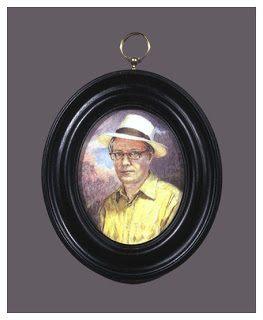 Tom Sully: Self Portrait, 2010, watercolor on ivory, 2 7/8 x 2 3/8 in.
Tom Sully: Self Portrait, 2010, watercolor on ivory, 2 7/8 x 2 3/8 in.
Number One London: You have a very famous great-great-great-grandfather, renowned portraitist Thomas Alfred Sully (1783-1872), who painted Queen Victoria and Thomas Jefferson, among others. How did it affect you having the same name as your grandfather and being an artist as well?
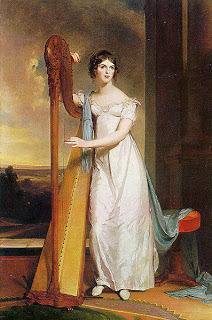 Thomas A. Sully (1783-1872), Lady with a Harp: Eliza Ridgely, 1818National Gallery of Art, Washington, D. C.
Thomas A. Sully (1783-1872), Lady with a Harp: Eliza Ridgely, 1818National Gallery of Art, Washington, D. C.
Tom Sully: As a young man I found Victorian art cloying. I decided to go to art school in California where few had ever heard of Thomas Sully. When I arrived in New York afterwards, theories of deconstruction held sway in the art world. While all my peers were making conceptual art, I turned to illustration for my living, since you still needed to know how to draw for that. My first portrait commission was from The New Yorker, who hired me to paint a singer performing at The Rainbow Room. It was then that I took Sully's Hints To Young Painters down from the shelf and got to work.
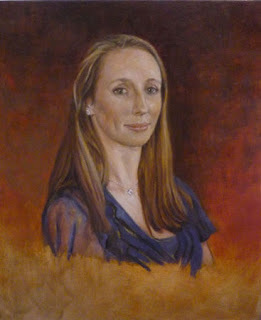 Tom Sully: Garland, 2012, oil on linen, 24 x 20
Tom Sully: Garland, 2012, oil on linen, 24 x 20
NOL: Have there been other people in the arts in your family?
TS: Sully's parents were actors and all his siblings were actors and musicians. His children painted - the most promising, another Thomas, unfortunately died young. I'm descended from Sully's son Alfred, an army general who painted Native American scenes while serving in the Dakotas. The most recent artist family member of note is Thomas O. Sully, a celebrated New Orleans architect who bridged the 19th and 20th centuries. His grandfather, the portraitist's brother, had moved to Louisiana in the early 1800s. When he wasn't designing Queen Anne-style Garden District mansions, the architect loved to hunt and fish in the Louisiana countryside. I feel a connection to him when I go into the bayous and swamps to find subjects for landscapes.
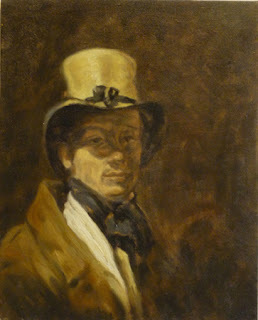 Tom Sully: After Henry Inman, 2011, oil on linen, 15 x 12 in.
Tom Sully: After Henry Inman, 2011, oil on linen, 15 x 12 in.
NOL: You have painted portraits, landscapes, and other relatively large-scale oil paintings for years. What inspired you to paint portrait miniatures?
TS: In 2001 I saw an amazing traveling exhibition. Love and Loss, American Portrait and Mourning Miniatures, organized by Robin Jaffee Frank at Yale University Art Gallery. What intrigued me was that these are intimate portraits, full of heartfelt, personal associations. These charged images sustained a current between people otherwise separated by the vagaries of life and geography, the daily routine, or even death. An image of a family member or loved one, small enough to be held in the hand and carried on your person, can take on the properties of a talisman. When worn, they become a public emblem of affection. They were and can still be used today as a catalyst in courtship. To me, this is portraiture at its best and about as far away from the institutional boardroom portrait as you can get! The show included a miniature Sully had painted to mourn the death of his mother. Of course, the technique and sheer artistry of these paintings is incredible. It took me awhile to track down the materials and get up the nerve to work so small.
NOL: Do you paint in the traditional technique with tiny stippled dots of watercolor on ivory?
TS: Yes, I use a combination of stippling and hatching, applying small amounts of paint and waiting for each layer to dry before adding the next, gradually and patiently building up richness and depth while achieving a likeness. A little like the rabbit hole in Alice in Wonderland, this small space becomes your world.
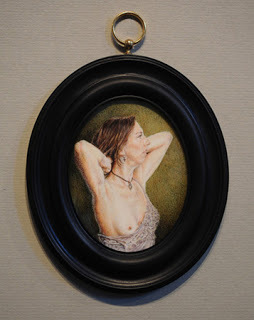 Tom Sully: Susan Tying Her Necklace, 2011, watercolor on ivory, 2 7/8 x 2 3/8 in.
Tom Sully: Susan Tying Her Necklace, 2011, watercolor on ivory, 2 7/8 x 2 3/8 in.
NOL: Do you work from photographs or do your miniature subjects pose while you sketch or paint?
TS: I like to work from photographs that I take myself. I find photography a useful conceptual tool - we can try out different angles on the face, different hairstyles, clothing, jewelry and lighting until we are happy with the composition in one or more of them. The photos do not then become "the be all and end all" but what Degas called an "aide de memoire." While I paint, I improve on the photos. Sentiment, emotion and empathy continually inform my hand. My ancestor said, "from long experience I know that resemblance in a portrait is essential; but no fault shall be found with the artist, at least by the sitter, if he improve the appearance".
NOL: How did you learn about the availability of woolly mammoth ivory?
TS: My first efforts were on Ivorine, a 20th century ivory substitute, and then vellum mounted on card. One supplier led me to another until I found someone in Dorset who could obtain mammoth ivory from Siberia where research crews have been finding whole woolly mammoths preserved in the permafrost. He has since sold his business but fortunately I have a pretty good stockpile.
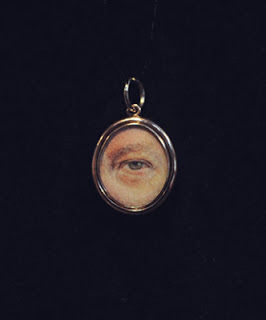 Tom Sully: Eric, His Eye, 2011, watercolor on ivory, 3/4 x 5/8 in.
Tom Sully: Eric, His Eye, 2011, watercolor on ivory, 3/4 x 5/8 in.
NOL: What led you to painting eye portraits?
TS: My interest was piqued by an article about eye portraits that I found in a 1904 issue of The Connoisseur. When a portrait commission took me to Philadelphia, I was spellbound by the collection at the Philadelphia Museum of Art. They are surely the most startling and, as portraits exchanged between lovers, the most romantic form of the art. There is a mystery to eye portraits that I'm unable to explain. It may come in part from seeing such an arresting image in so small a format - they are usually no bigger than one-half to three-quarters of an inch. In the Look of Love show currently at the Birmingham Museum of Art, there are stick pins and rings with images even smaller! In my experience of painting these, people that know the portrait subject immediately recognize them from this one fragment. I also find that they resonate well with a contemporary art audience. As I said to my wife one day, "eye portraits are so damn strange that they may as well be cutting-edge contemporary art!"
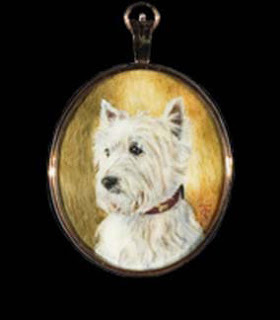 Tom Sully: Lucy, watercolor on ivory, 2/2 x 2 1/8 in. NOL: We noticed on your website that you also paint dogs.
Tom Sully: Lucy, watercolor on ivory, 2/2 x 2 1/8 in. NOL: We noticed on your website that you also paint dogs.
TS: I love painting dog portraits. One need only look at the work of Sir Edwin Landseer to see that dog painting is serious business. Dogs are great to work with since they are less self-conscious than we are. A British client hired me to paint miniatures of his two bulldogs. When one of them died about six months later, we realized we had been unknowingly prescient. I painted a West Highland Terrier in Palm Beach who was so poised that she must have been a fashion model in a previous life.
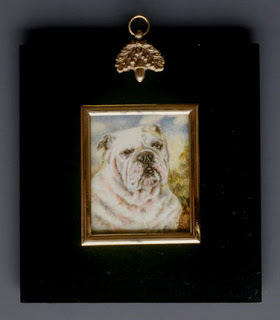 Tom Sully: Solomon, 2006, watercolor on ivory, 2 1/2 x 2 1/16 in.
Tom Sully: Solomon, 2006, watercolor on ivory, 2 1/2 x 2 1/16 in.
NOL: What do you charge for a portrait miniature? TS: I charge $3,000 for a head and shoulders to half-length portrait miniature and $2,500 for an eye portrait. These prices include the cost of a locket in rose gold, yellow gold or sterling silver.
NOL: Tell us about your current work?
TS: I'm currently painting an eye portrait commission for a client in Birmingham, Alabama. I'm also working on a body of Louisiana inspired landscapes for a show in New Orleans this fall. I used to live there and began exploring the countryside for landscape subjects during the evacuation from Hurricane Katrina. The bayou country and especially the swamps, which seem to exist outside of time and civilization, are a great subject for a painter with a Romantic bent.
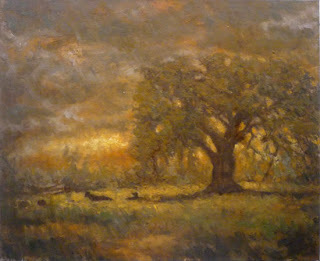 Tom Sully: Grand Coteau Oak, 2012, oil on linen 22 x 27 in.
Tom Sully: Grand Coteau Oak, 2012, oil on linen 22 x 27 in.
NOL: What are your upcoming exhibitions?
TS: Louisiana Reveries: Landscapes by Thomas Sully, October 6 - 31, 2012;Jean Bragg Gallery of Southern Art, 600 Julia Street, New Orleans, Louisiana.
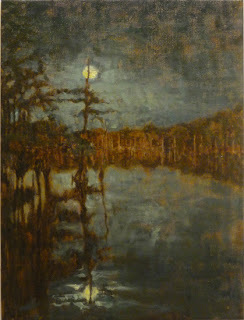 Tom Sully: Nocturne in Blue and Gold, 2011, oil on linen 24 x 18 in.
Tom Sully: Nocturne in Blue and Gold, 2011, oil on linen 24 x 18 in.
NOL: Many thanks to you, Tom Sully. Your life and work are fascinating. Visit Tom Sully's website here to see more of his work.
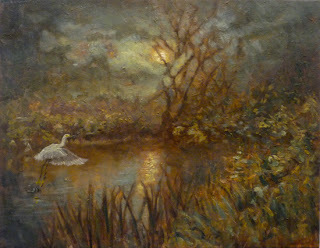 Tom Sully: Night Flight, 2012, oil on linen, 17 x 24 in.
Tom Sully: Night Flight, 2012, oil on linen, 17 x 24 in.

 Tom Sully: Self Portrait, 2010, watercolor on ivory, 2 7/8 x 2 3/8 in.
Tom Sully: Self Portrait, 2010, watercolor on ivory, 2 7/8 x 2 3/8 in.Number One London: You have a very famous great-great-great-grandfather, renowned portraitist Thomas Alfred Sully (1783-1872), who painted Queen Victoria and Thomas Jefferson, among others. How did it affect you having the same name as your grandfather and being an artist as well?
 Thomas A. Sully (1783-1872), Lady with a Harp: Eliza Ridgely, 1818National Gallery of Art, Washington, D. C.
Thomas A. Sully (1783-1872), Lady with a Harp: Eliza Ridgely, 1818National Gallery of Art, Washington, D. C.Tom Sully: As a young man I found Victorian art cloying. I decided to go to art school in California where few had ever heard of Thomas Sully. When I arrived in New York afterwards, theories of deconstruction held sway in the art world. While all my peers were making conceptual art, I turned to illustration for my living, since you still needed to know how to draw for that. My first portrait commission was from The New Yorker, who hired me to paint a singer performing at The Rainbow Room. It was then that I took Sully's Hints To Young Painters down from the shelf and got to work.
 Tom Sully: Garland, 2012, oil on linen, 24 x 20
Tom Sully: Garland, 2012, oil on linen, 24 x 20NOL: Have there been other people in the arts in your family?
TS: Sully's parents were actors and all his siblings were actors and musicians. His children painted - the most promising, another Thomas, unfortunately died young. I'm descended from Sully's son Alfred, an army general who painted Native American scenes while serving in the Dakotas. The most recent artist family member of note is Thomas O. Sully, a celebrated New Orleans architect who bridged the 19th and 20th centuries. His grandfather, the portraitist's brother, had moved to Louisiana in the early 1800s. When he wasn't designing Queen Anne-style Garden District mansions, the architect loved to hunt and fish in the Louisiana countryside. I feel a connection to him when I go into the bayous and swamps to find subjects for landscapes.
 Tom Sully: After Henry Inman, 2011, oil on linen, 15 x 12 in.
Tom Sully: After Henry Inman, 2011, oil on linen, 15 x 12 in.NOL: You have painted portraits, landscapes, and other relatively large-scale oil paintings for years. What inspired you to paint portrait miniatures?
TS: In 2001 I saw an amazing traveling exhibition. Love and Loss, American Portrait and Mourning Miniatures, organized by Robin Jaffee Frank at Yale University Art Gallery. What intrigued me was that these are intimate portraits, full of heartfelt, personal associations. These charged images sustained a current between people otherwise separated by the vagaries of life and geography, the daily routine, or even death. An image of a family member or loved one, small enough to be held in the hand and carried on your person, can take on the properties of a talisman. When worn, they become a public emblem of affection. They were and can still be used today as a catalyst in courtship. To me, this is portraiture at its best and about as far away from the institutional boardroom portrait as you can get! The show included a miniature Sully had painted to mourn the death of his mother. Of course, the technique and sheer artistry of these paintings is incredible. It took me awhile to track down the materials and get up the nerve to work so small.
NOL: Do you paint in the traditional technique with tiny stippled dots of watercolor on ivory?
TS: Yes, I use a combination of stippling and hatching, applying small amounts of paint and waiting for each layer to dry before adding the next, gradually and patiently building up richness and depth while achieving a likeness. A little like the rabbit hole in Alice in Wonderland, this small space becomes your world.
 Tom Sully: Susan Tying Her Necklace, 2011, watercolor on ivory, 2 7/8 x 2 3/8 in.
Tom Sully: Susan Tying Her Necklace, 2011, watercolor on ivory, 2 7/8 x 2 3/8 in.NOL: Do you work from photographs or do your miniature subjects pose while you sketch or paint?
TS: I like to work from photographs that I take myself. I find photography a useful conceptual tool - we can try out different angles on the face, different hairstyles, clothing, jewelry and lighting until we are happy with the composition in one or more of them. The photos do not then become "the be all and end all" but what Degas called an "aide de memoire." While I paint, I improve on the photos. Sentiment, emotion and empathy continually inform my hand. My ancestor said, "from long experience I know that resemblance in a portrait is essential; but no fault shall be found with the artist, at least by the sitter, if he improve the appearance".
NOL: How did you learn about the availability of woolly mammoth ivory?
TS: My first efforts were on Ivorine, a 20th century ivory substitute, and then vellum mounted on card. One supplier led me to another until I found someone in Dorset who could obtain mammoth ivory from Siberia where research crews have been finding whole woolly mammoths preserved in the permafrost. He has since sold his business but fortunately I have a pretty good stockpile.
 Tom Sully: Eric, His Eye, 2011, watercolor on ivory, 3/4 x 5/8 in.
Tom Sully: Eric, His Eye, 2011, watercolor on ivory, 3/4 x 5/8 in.NOL: What led you to painting eye portraits?
TS: My interest was piqued by an article about eye portraits that I found in a 1904 issue of The Connoisseur. When a portrait commission took me to Philadelphia, I was spellbound by the collection at the Philadelphia Museum of Art. They are surely the most startling and, as portraits exchanged between lovers, the most romantic form of the art. There is a mystery to eye portraits that I'm unable to explain. It may come in part from seeing such an arresting image in so small a format - they are usually no bigger than one-half to three-quarters of an inch. In the Look of Love show currently at the Birmingham Museum of Art, there are stick pins and rings with images even smaller! In my experience of painting these, people that know the portrait subject immediately recognize them from this one fragment. I also find that they resonate well with a contemporary art audience. As I said to my wife one day, "eye portraits are so damn strange that they may as well be cutting-edge contemporary art!"
 Tom Sully: Lucy, watercolor on ivory, 2/2 x 2 1/8 in. NOL: We noticed on your website that you also paint dogs.
Tom Sully: Lucy, watercolor on ivory, 2/2 x 2 1/8 in. NOL: We noticed on your website that you also paint dogs.TS: I love painting dog portraits. One need only look at the work of Sir Edwin Landseer to see that dog painting is serious business. Dogs are great to work with since they are less self-conscious than we are. A British client hired me to paint miniatures of his two bulldogs. When one of them died about six months later, we realized we had been unknowingly prescient. I painted a West Highland Terrier in Palm Beach who was so poised that she must have been a fashion model in a previous life.
 Tom Sully: Solomon, 2006, watercolor on ivory, 2 1/2 x 2 1/16 in.
Tom Sully: Solomon, 2006, watercolor on ivory, 2 1/2 x 2 1/16 in.NOL: What do you charge for a portrait miniature? TS: I charge $3,000 for a head and shoulders to half-length portrait miniature and $2,500 for an eye portrait. These prices include the cost of a locket in rose gold, yellow gold or sterling silver.
NOL: Tell us about your current work?
TS: I'm currently painting an eye portrait commission for a client in Birmingham, Alabama. I'm also working on a body of Louisiana inspired landscapes for a show in New Orleans this fall. I used to live there and began exploring the countryside for landscape subjects during the evacuation from Hurricane Katrina. The bayou country and especially the swamps, which seem to exist outside of time and civilization, are a great subject for a painter with a Romantic bent.
 Tom Sully: Grand Coteau Oak, 2012, oil on linen 22 x 27 in.
Tom Sully: Grand Coteau Oak, 2012, oil on linen 22 x 27 in. NOL: What are your upcoming exhibitions?
TS: Louisiana Reveries: Landscapes by Thomas Sully, October 6 - 31, 2012;Jean Bragg Gallery of Southern Art, 600 Julia Street, New Orleans, Louisiana.
 Tom Sully: Nocturne in Blue and Gold, 2011, oil on linen 24 x 18 in.
Tom Sully: Nocturne in Blue and Gold, 2011, oil on linen 24 x 18 in.NOL: Many thanks to you, Tom Sully. Your life and work are fascinating. Visit Tom Sully's website here to see more of his work.
 Tom Sully: Night Flight, 2012, oil on linen, 17 x 24 in.
Tom Sully: Night Flight, 2012, oil on linen, 17 x 24 in.
Published on March 25, 2012 01:00
March 23, 2012
The Civil War Connection: Lord Palmerston and the Battle of Antietam
I recently visited the Antietam National Battleground in Maryland where the bloodiest day in U.S. military history took place on September 17, 1862. And it has a direct connection to our usual British topics.
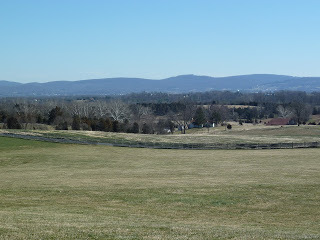 Antietam National Battleground, Maryland
Antietam National Battleground, Maryland
On a warm and sunny March day, we drove into the foothills of the Maryland mountains to visit Antietam, well run by the National Park Service. Like many U.S. Civil War battlegrounds, this one is so quiet and peaceful today that it is difficult to envision the carnage that took place almost 150 years ago.
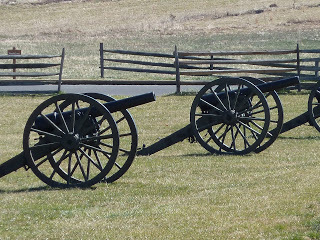
The grounds are marked with many cannons and memorials to the various regiments which fought here on the side of the Union and for the Confederacy (in the south, it is known as the Battle of Sharpsburg, a nearby village).
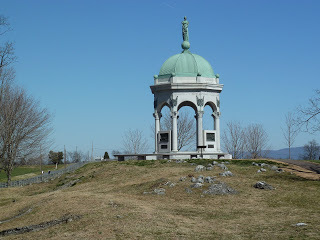 Maryland State Monument, the only one dedicated to troops from that state who served on both sides
Maryland State Monument, the only one dedicated to troops from that state who served on both sides
The calm beauty of the area belies it bloody past. After viewing a film presentation on the battle and its aftermath, we purchased a CD for our car which took us on a driving tour of the principal sites. At each one, we could park and listen to the description, then walk around the locale and talk with the very knowledgeable volunteer guides -- who spend their weekends telling visitors about the people who fought here and what happened to many of them. Special thanks to Jim, Marty and Dave who told us so many facts and personal stories.
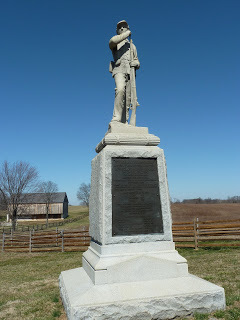
A future U.S President was among the Union troops. William McKinley (1843-1901), 25th President, was later promoted to the officer corps. His mentor in the 23rd Ohio Infantry, Rutherford B. Hayes (1822-1893), to become the 19th U.S. President, had been recently wounded and did not fight at Antietam.
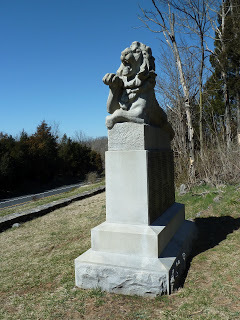 Monument to the 15th Massachusetts Volunteer Infantry
Monument to the 15th Massachusetts Volunteer Infantry
Skipping ahead to the outcome of the battle, the Union troops prevailed although the losses on both sides were horrendous and crippling. The appearance of a strategic Union victory, however, was said to have caused Lord Palmerston, British Prime Minister at the time, to abandon his inclination to support the Confederacy. Both the British and the French governments declined to take part in mediating the conflict. Some observers -- many as a matter of fact -- believe that Palmerston was hoping to teach the upstart United States a lesson.
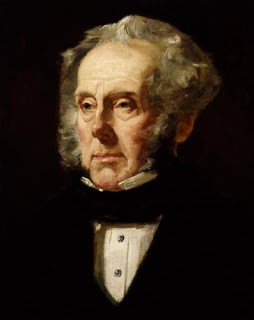 Lord Palmerston (1784-1865) by Francis Cruikshank, 1855
Lord Palmerston (1784-1865) by Francis Cruikshank, 1855
In addition, the success of the Union troops spurred President Lincoln to issue the Emancipation Proclamation in September, 1862, which freed all slaves living in Confederate states and further contributed to the British decision not to support the Confederacy.
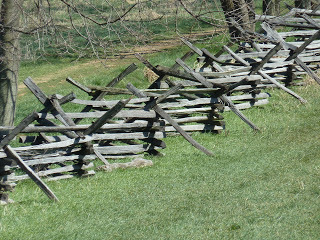 The self-supporting (nail-less) fences
The self-supporting (nail-less) fences
Another noteworthy matter is the role that photography played in popular views of war. For the first time, photographers, foremost among them Matthew Brady, set up their equipment and took photos of the battleground littered with the dead and dying. When these scenes were published, the public was horrified. People were used to seeing engravings (think Currier and Ives) of gallant charges with flags flying, not piles of grotesquely twisted bodies.
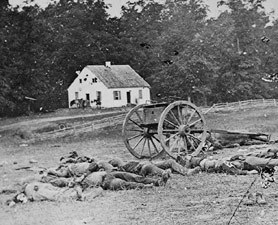
.
Ironically, much of the fighting was done around the Dunker Church, which belonged to a German Christian sect advocating peaceful resolution of all conflicts.
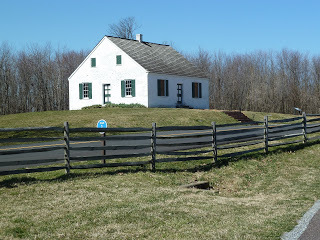 Dunker Church
Dunker Church
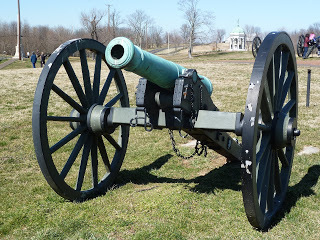 A Napoleon cannon
A Napoleon cannon
The American Civil War was fought with weapons very similar to those used in the Napoleonic Wars. The armies had more rifles, thus more accurate shots. And some of the canons, such as the first ones in the second picture of this post, were rifled as well, which improved their accuracy too. Those just above and below were almost exact duplicates of the cannons used in the Peninsular War and at Waterloo.
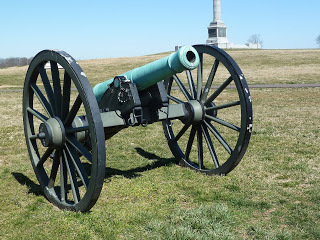 A "Napoleon" cannon
A "Napoleon" cannon
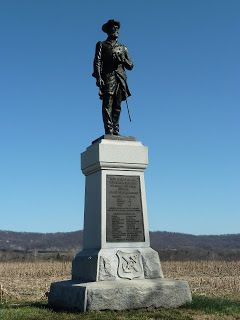 Monument to the 50th Pennsylvania Volunteer Infantry
Monument to the 50th Pennsylvania Volunteer Infantry
All day the battle raged back and forth among the cornfields, hills and hollows of the area, with each side moving forward and then retreating as the advantage changed from side to side.
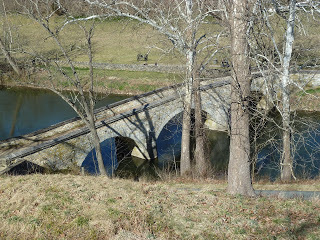 Burnside's Bridge
Burnside's Bridge
In the afternoon, at the beautiful old stone bridge over Antietam Creek now known as Burnside's Bridge, northern troops led by Major General Ambrose Burnside, gained the upper hand, causing the southerners to withdraw. But more fighting followed as fresh troops arrived on both sides.
Late in the day, there was an undeclared truce as both armies tried to comprehend the extent of their losses. Some units had only a handful of their men remaining unhurt.
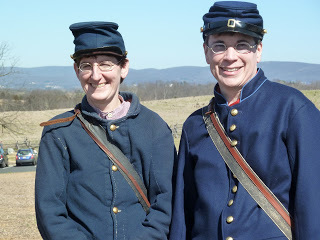
But wait, it was not only men that fought. As the above ladies who volunteer at the site told us, there were some women among the troops. They managed to pass as men throughout the war, an amazing feat in itself. No one can come up with the exact number but we have the personal accounts of some who recorded their experiences for posterity.
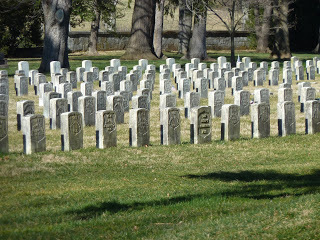
Fittingly, the final stop on the battlefield tour is at the Union Cemetery where many thousands are buried, including a number still unidentified. The cemetery is watched over by the monumental statue of an infantry private, called Old Simon
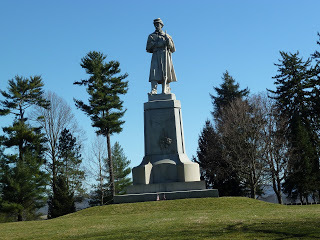
And as a final comment, the guides told us that President Lincoln was most unhappy that his commander, General George McClellan was so cautious. McClellan did not pursue Lee's army back across the Potomac and into Virginia. Perhaps, if he had followed up quickly, the war would have been over in weeks or months instead of three more years of fighting.
More than 3,600 died that day, and many more of the additional 20,000 casualties never recovered. Though the result of the battle was a tactical draw, the South failed to defeat the North in the first battle on Northern territory. The North managed to reverse its previous record of mostly losses. Less than a year later, at Gettysburg, the tide of the war would change in favor of the North.
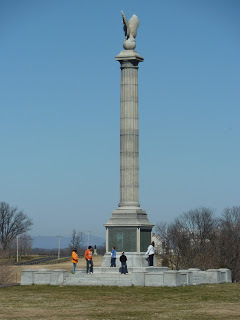 New York State Monument
New York State Monument
For more details on the battle and the upcoming 150th Anniversary of the Battle of Antietam, click here.

 Antietam National Battleground, Maryland
Antietam National Battleground, MarylandOn a warm and sunny March day, we drove into the foothills of the Maryland mountains to visit Antietam, well run by the National Park Service. Like many U.S. Civil War battlegrounds, this one is so quiet and peaceful today that it is difficult to envision the carnage that took place almost 150 years ago.

The grounds are marked with many cannons and memorials to the various regiments which fought here on the side of the Union and for the Confederacy (in the south, it is known as the Battle of Sharpsburg, a nearby village).
 Maryland State Monument, the only one dedicated to troops from that state who served on both sides
Maryland State Monument, the only one dedicated to troops from that state who served on both sides The calm beauty of the area belies it bloody past. After viewing a film presentation on the battle and its aftermath, we purchased a CD for our car which took us on a driving tour of the principal sites. At each one, we could park and listen to the description, then walk around the locale and talk with the very knowledgeable volunteer guides -- who spend their weekends telling visitors about the people who fought here and what happened to many of them. Special thanks to Jim, Marty and Dave who told us so many facts and personal stories.

A future U.S President was among the Union troops. William McKinley (1843-1901), 25th President, was later promoted to the officer corps. His mentor in the 23rd Ohio Infantry, Rutherford B. Hayes (1822-1893), to become the 19th U.S. President, had been recently wounded and did not fight at Antietam.
 Monument to the 15th Massachusetts Volunteer Infantry
Monument to the 15th Massachusetts Volunteer InfantrySkipping ahead to the outcome of the battle, the Union troops prevailed although the losses on both sides were horrendous and crippling. The appearance of a strategic Union victory, however, was said to have caused Lord Palmerston, British Prime Minister at the time, to abandon his inclination to support the Confederacy. Both the British and the French governments declined to take part in mediating the conflict. Some observers -- many as a matter of fact -- believe that Palmerston was hoping to teach the upstart United States a lesson.
 Lord Palmerston (1784-1865) by Francis Cruikshank, 1855
Lord Palmerston (1784-1865) by Francis Cruikshank, 1855In addition, the success of the Union troops spurred President Lincoln to issue the Emancipation Proclamation in September, 1862, which freed all slaves living in Confederate states and further contributed to the British decision not to support the Confederacy.
 The self-supporting (nail-less) fences
The self-supporting (nail-less) fencesAnother noteworthy matter is the role that photography played in popular views of war. For the first time, photographers, foremost among them Matthew Brady, set up their equipment and took photos of the battleground littered with the dead and dying. When these scenes were published, the public was horrified. People were used to seeing engravings (think Currier and Ives) of gallant charges with flags flying, not piles of grotesquely twisted bodies.

.
Ironically, much of the fighting was done around the Dunker Church, which belonged to a German Christian sect advocating peaceful resolution of all conflicts.
 Dunker Church
Dunker Church A Napoleon cannon
A Napoleon cannonThe American Civil War was fought with weapons very similar to those used in the Napoleonic Wars. The armies had more rifles, thus more accurate shots. And some of the canons, such as the first ones in the second picture of this post, were rifled as well, which improved their accuracy too. Those just above and below were almost exact duplicates of the cannons used in the Peninsular War and at Waterloo.
 A "Napoleon" cannon
A "Napoleon" cannon  Monument to the 50th Pennsylvania Volunteer Infantry
Monument to the 50th Pennsylvania Volunteer InfantryAll day the battle raged back and forth among the cornfields, hills and hollows of the area, with each side moving forward and then retreating as the advantage changed from side to side.
 Burnside's Bridge
Burnside's BridgeIn the afternoon, at the beautiful old stone bridge over Antietam Creek now known as Burnside's Bridge, northern troops led by Major General Ambrose Burnside, gained the upper hand, causing the southerners to withdraw. But more fighting followed as fresh troops arrived on both sides.
Late in the day, there was an undeclared truce as both armies tried to comprehend the extent of their losses. Some units had only a handful of their men remaining unhurt.

But wait, it was not only men that fought. As the above ladies who volunteer at the site told us, there were some women among the troops. They managed to pass as men throughout the war, an amazing feat in itself. No one can come up with the exact number but we have the personal accounts of some who recorded their experiences for posterity.

Fittingly, the final stop on the battlefield tour is at the Union Cemetery where many thousands are buried, including a number still unidentified. The cemetery is watched over by the monumental statue of an infantry private, called Old Simon

And as a final comment, the guides told us that President Lincoln was most unhappy that his commander, General George McClellan was so cautious. McClellan did not pursue Lee's army back across the Potomac and into Virginia. Perhaps, if he had followed up quickly, the war would have been over in weeks or months instead of three more years of fighting.
More than 3,600 died that day, and many more of the additional 20,000 casualties never recovered. Though the result of the battle was a tactical draw, the South failed to defeat the North in the first battle on Northern territory. The North managed to reverse its previous record of mostly losses. Less than a year later, at Gettysburg, the tide of the war would change in favor of the North.
 New York State Monument
New York State Monument For more details on the battle and the upcoming 150th Anniversary of the Battle of Antietam, click here.
Published on March 23, 2012 01:00
March 21, 2012
God Save the Queen(s)
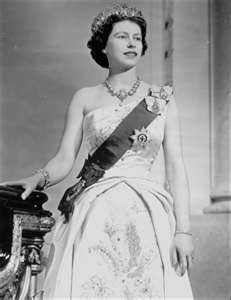
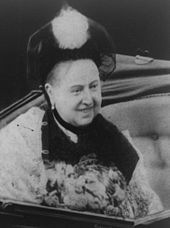
In this Diamond Jubilee year, it's perhaps fitting to reflect upon the reigns of both Queen Elizabeth II and Queen Victoria, England's two longest reigning monarchs. To date, Queen Elizabeth has been on the throne for 60 years and still has a few years to go before breaking the regal record held by Queen Victoria for a reign of 63 years and 7 months (and 2 days).
Naturally, all monarchs begin their reigns upon the death of their predecessor.
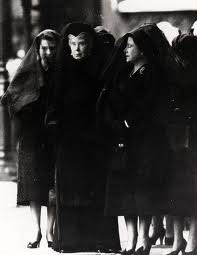
Queen Elizabeth, her grandmother, Queen Mary and her mother, Queen Elizabeth, the Queen Mother at the funeral of Queen Elizabeth's father, King George VI in February, 1952.
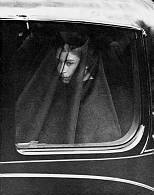
However, as is well known, Queen Victoria took her mourning upon the early death of her husband, Prince Albert, to a whole new level.
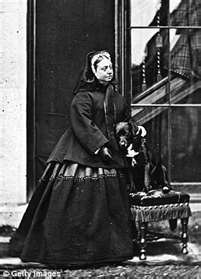
The widowed Queen Victoria
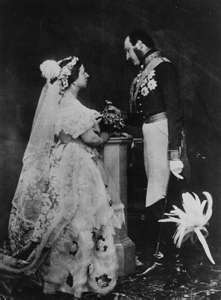
To back up a bit, Victoria and her cousin Albert were married on February 10th, 1840, at the royal chapel of St. James, in London.
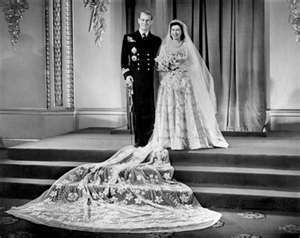
Queen Elizabeth and her cousin, Prince Philip, were married on November 20, 1947 in Westminster Abbey, London.
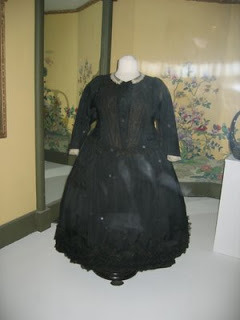
Queen Victoria's uninterrupted mourning affected all aspects of her life, not the least of which was her fashion sense, as can be seen by the dress above, on display at the Costume Museum in Bath. Queen Victoria stood a mere five feet tall and, as the above dress will attest, seemingly enjoyed her food.
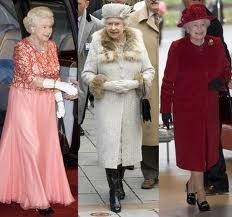
In contrast, Queen Elizabeth stands at a comparatively statuesque 5' 4", eats a bit less and is known for wearing an often bright and always colourful wardrobe.
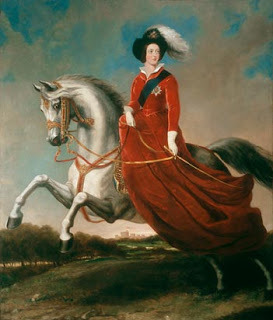
One thing that Queen Victoria and Queen Elizabeth have in common is their love for horses and horseback riding. Each began riding early in their lives and continued to ride as long as they were able. Queen Elizabeth is still in the saddle . . . . .
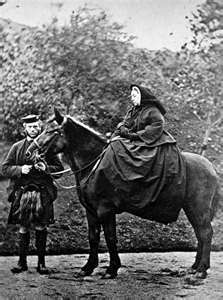
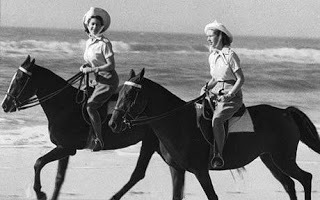
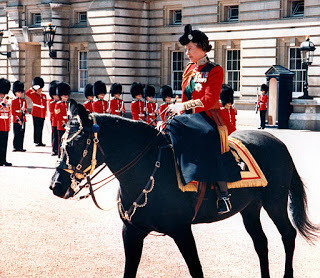
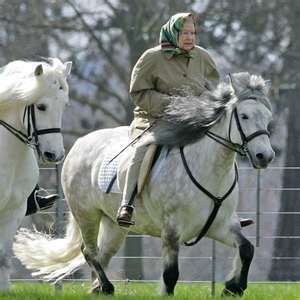
Queen Victoria's Diamond Jubilee was marked by many celebrations, including, on 22 June 1897, a progress to St Paul's Cathedral, where a short service of thanksgiving was held outside the building, as the Queen was too lame to manage the steps. Thankfully, Queen Elizabeth is in fine health and a host of Jubilee celebrations will be held throughout the land over the coming months.
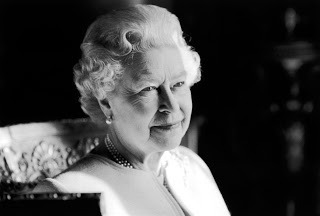
The Queen's 80th birthday portrait, taken in February 2006
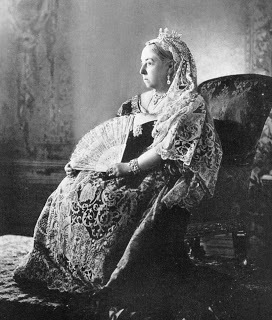
Queen Victoria's Diamond Jubilee Photo
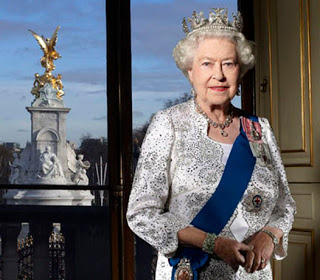
Queen Elizabeth II's Official Diamond Jubilee Portrait
Published on March 21, 2012 00:41
March 19, 2012
Dark Shadows
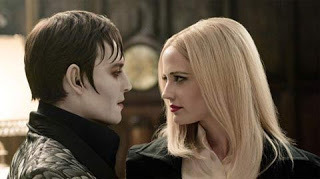
Anyone of a certain age will recall coming home after school in time to watch Dark Shadows on the telly, which spoke to our generation in a way our mother's soap operas could not. Many of us were Barnabas Collins fans, including Johnny Depp, who fought for years to bring the story to the big screen. "I do remember, very vividly, practically sprinting home from school in the afternoon to see Jonathan Frid play Barnabas Collins," the actor says. "Even then, at that age, I knew — this has got to be weird."
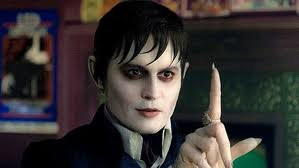
How appropo, as these days anything starring Johnny Depp has typically got to be a tad weird. And directed by Tim Burton, as this film is. And to co-star Helena Bonham Carter, which this film does. She plays Dr. Julia Hoffman. See below. And to feature Depp in wacky make up. Done. See above. And below, in the first photo of Depp as Tonto in the new Lone Ranger movie.
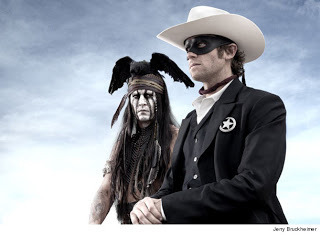
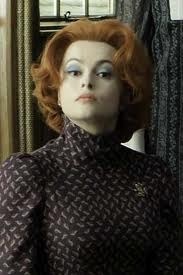
But I digress . . . . . the new Dark Shadows storyline begins in the 18th century, when Barnabas is turned into a vampire by the brokenhearted witch Angelique (Eva Green) and buried alive. The film then flashes forward two centuries, as Barnabas is freed from his tomb and returns to his home and the dysfunctional relatives who now reside there.
Principals involved in the film have given us a less clear vision of what to expect from the film:
"We're changing it a little bit," Burton said last fall. "I wouldn't do it if it felt like it was just doing the same thing. For me, it's about trying to go back to the original drawings and kind of capture that spirit a little bit more of what the drawings are. It feels different even though it's a similar story, but we're kind of expanding it a bit.
Bonham Carter muddled the water even further via the following comment, "It's very original, and it's kind of uncategorizable," she said. "It's going to be impossible to sell, frankly, because it's a soap opera, but it's very, very subtle, I don't know. We'll see. It's a ghost story, but then it's an unhappy vampire story."
The film opens in theaters on May 11th, and no doubt the characters will garner themselves a whole new set of fans. If, that is, anyone comes away with a clear understanding of what the film was actually about.
So what's next for Depp, who has never been one to rest long upon his laurels? The big screen version of The Night Stalker, with Depp playing Kolchak, the reporter in the seersucker suit who keeps running into monsters on his beat, originally played by Darren McGavin. No doubt there'll be a part for Helena in this one, as well.
Published on March 19, 2012 01:11
March 16, 2012
The Earl's Court Wheel
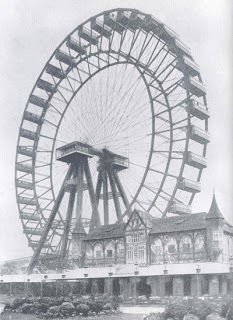
From Discoveries and Inventions of the 19th Century (1898) by Robert Routledge
" . . . . . . amid the attractions of an International Exhibition, it was not lost upon the enterprising people of the States when the " World's Fair" at Chicago was in preparation in 1893. It was then that Mr. G. W. G. Ferris, the head of a firm of bridge constructors at Pittsburg, conceived the idea of applying his engineering skill to the erection of a huge wheel, revolving in a vertical plane, with cars for persons to sit in, constituting, in fact, an enormous "merry-go-round," as the machine once so common at country fairs was called. The novelty of the Chicago erection was, therefore, not the general idea, but the magnitude of the scale, which, for that reason, involved the application of the highest engineering skill, and the solution of hitherto unattempted practical problems. Several thousand pounds were, in fact, expended on merely preliminary plans and designs. The great wheel at Chicago was 350 feet in diameter, and to its periphery were hung thirty-six carriages, each seating forty persons. At each revolution, therefore, 1,440 people would be raised in the air to the height of 250 feet, and from that elevation afforded a splendid prospect, besides an experience of the peculiar sensation like that of being in a balloon, when the spectator has no perception of his own motion, but the objects beneath appear to have the contrary movement, that is to say, they seem to be sinking when he is rising, and viceversd.
"This curious structure was not begun until March, 1893, yet it was set in motion three months afterwards, having cost about £62,500. The Company had to hand over to the Exhibition one half of the receipts after the big wheel had paid for its construction, but even then they realised a handsome profit, and at the close of the World's Fair, they sold the machine for four-thirds of its cost, in order that it might be re-erected at Coney Island.
"No sooner had the great Ferris wheel at Chicago proved a financial success than an American gentleman, Lieutenant Graydon, secured a patent for a like machine in the Un1ted Kingdom; and as it has now become almost a matter of course that some iron or steel structure, surpassing everything before attempted, should form a part of each great exhibition, a Company was at once formed in London, under the title of "The Gigantic Wheel and Recreation Towers Co., Limited," to construct and work at the Earl's Court Oriental Exhibition of 1895, a great wheel, similar in general form to that of Chicago. But the design of the London wheel had some new features . . . and, moreover, having been planned of larger dimensions than its American prototype, presented additional engineering problems of no small complexity. After due deliberation the scheme of the work was entrusted to Mr. Walter B. Bassett, a talented young engineer, connected with the firm of Messrs. Maudslay, Sons, & Field, and already experienced in designing iron structures. Under this gentleman, with the assistance of Mr. J. J. Webster in carrying out some of the details, the work has been so successfully accomplished that the " Great Wheel"- of 1895 may be cited as one of the crowning mechanical triumphs of the nineteenth century. . . .
"The wheel at Earl's Court exceeds the Ferris wheel in diameter by 50 feet, being 300 feet across. It is supported on two towers, 175 feet high, each formed by four columns 4 feet square, built of steel plates with internal diaphragms, and surmounted by balconies that may be ascended in elevators raised by a weight of water, which, after having been discharged into a reservoir under the ground level, is again pumped up to the top of the towers. Between the balconies on each tower there is also a communication through the axle of the wheel, which, instead of being solid as at Chicago, is a tube of 7 feet diameter, and 35 feet long, made in sections, riveted together, of steel 1 inch thick, and weighing no less than 58 tons."
You can read much more about the history of Earl's Court as an entertainment venue here. Other rides included a Water Chute and showman who appeared at the grounds included none other than Buffalo Bill, show below at Earl's Court.
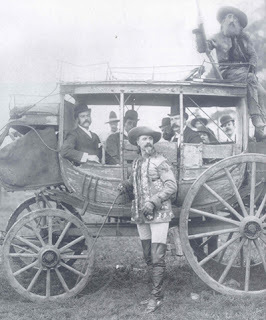
[image error]
Published on March 16, 2012 21:36
March 15, 2012
Sedan Chairs
Sedan chairs, also called litters, are enclosed seats carried on poles that have been used for centuries, or at least as early as the Eyptian Empire. Sedan chairs were introduced to Britain from Spain - before leaving Madrid in 1623 to return to England, the Prince of Wales, later Charles I, was given a gift by the Prime Minister that included "three sedan chairs of curious workmanship." He later gave two of these chairs to the Duke of Buckingham, who used them in the streets of London and prompted outrage for "reducing free born Englishmen to the condition of beasts of burden."
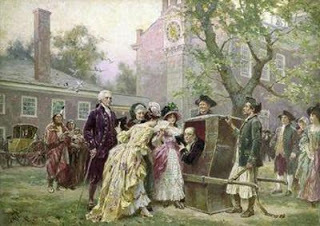
Benjamin Franklin in his sedan chair
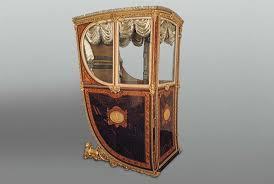
Sedan chair made for Queen Maria Luisa of Parma circa 1795
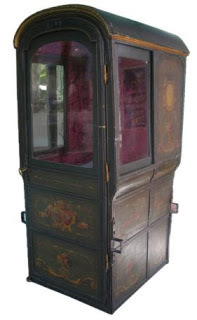
A late 18th century French sedan chair - click here to see the inside
By 1726 there were 400 sedan chairs registered in London. They were used in Edinburgh until the 1860's.
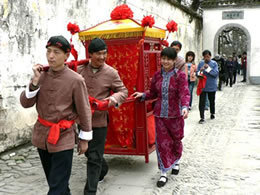
Above is a modern day Chinese sedan chair, traditionally used to carry a bride to her wedding. There is also a foundation in Hong Kong that raises money through their Sedan Chair Charities Fund and annual sedan chair races. Come to that, there are even sedan chair races still going on in England.
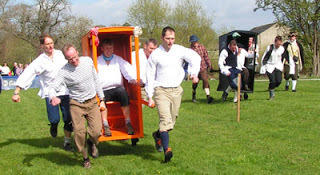
You can see examples of sedan chairs in museums throughout Great Britain:
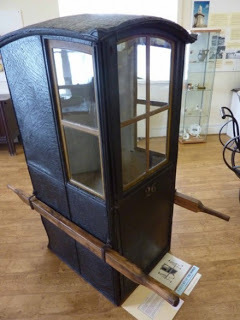
From the Tenby Museum and Art Gallery
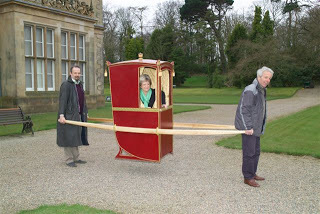
From the Ulster Folk and Transport Museum
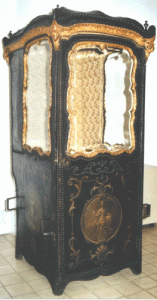
From the Museum of Leathercraft
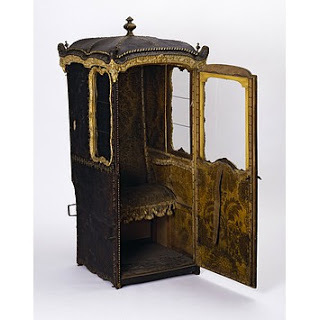
From the Victoria and Albert Museum
And coming full circle, the sedan chair of Queen Hetepheres from the Egyptian Museum, Cairo
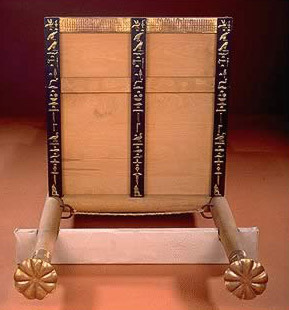 [image error]
[image error]

Benjamin Franklin in his sedan chair

Sedan chair made for Queen Maria Luisa of Parma circa 1795

A late 18th century French sedan chair - click here to see the inside
By 1726 there were 400 sedan chairs registered in London. They were used in Edinburgh until the 1860's.

Above is a modern day Chinese sedan chair, traditionally used to carry a bride to her wedding. There is also a foundation in Hong Kong that raises money through their Sedan Chair Charities Fund and annual sedan chair races. Come to that, there are even sedan chair races still going on in England.

You can see examples of sedan chairs in museums throughout Great Britain:

From the Tenby Museum and Art Gallery

From the Ulster Folk and Transport Museum

From the Museum of Leathercraft

From the Victoria and Albert Museum
And coming full circle, the sedan chair of Queen Hetepheres from the Egyptian Museum, Cairo
 [image error]
[image error]
Published on March 15, 2012 07:58
March 13, 2012
Captain Gronow on His School Friend Shelley
Rees Howell Gronow (1794-1865) wrote his Reminiscences late in his life. He knew many leading figures of his era. Below are his comments on Percy Bysshe Shelley (1792-1822), one of the most famous of the Romantic Era English Poets.
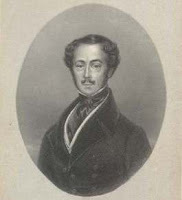 Rees Gronow
Rees Gronow
SHELLEY
Shelley, the poet, cut off at so early an age; just when his great poetical talents had been matured by study and reflection, and when he probably would have produced some great work, was my friend and associate at Eton. He was a boy of studious and meditative habits, averse to all games and sports, and a great reader of novels and romances. He was a thin, slight lad, with remarkably lustrous eyes, fine hair, and a very peculiar shrill voice and laugh. His most intimate friend at Eton was a boy named Price, who was considered one of the best classical scholars amongst us. At his tutor, Bethell's, where he lodged, he attempted many mechanical and scientific experiments. By the aid of a common tinker, he contrived to make something like a steam-engine, which, unfortunately, one day suddenly exploded; to the great consternation of the neighbourhood and to the imminent danger of a severe flogging from Dr. Reate.
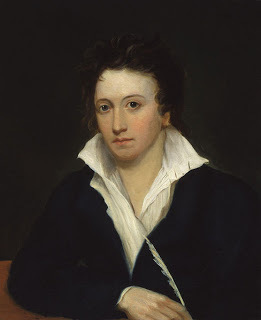 Percy Byssche Shelley
Percy Byssche Shelley
Soon after leaving school, and about the year 1810, he came, in a state of great distress and difficulty, to Swansea, when we had an opportunity of rendering him a service; but we never could ascertain what had brought him to Wales, though we had reason to suppose it was some mysterious affaire du coeur.
The last time I saw Shelley was at Genoa, in 1822, sitting on the sea-shore, and, when I came upon him, making a true poet's meal of bread and fruit; He at once recognized me, jumped up, and appearing greatly delighted, exclaimed, "Here you see me at my old Eton habits; but instead of the green fields for a couch, I have here the shores of the Mediterranean. It is very grand, and very romantic. I only wish I had some of the excellent brown bread and butter we used to get at Spiers's: but I was never very fastidious in my diet." Then he continued, in a wild and eccentric manner: "Gronow, do you remember the beautiful Martha, the Hebe of Spiers's? She was the loveliest girl I ever saw, and I loved her to distraction."
Shelley was looking careworn and ill; and, as usual, was very carelessly dressed. He had on a large and wide straw hat, his long brown hair, already streaked with grey, flowing in large masses from under it, and presented a wild and strange appearance.
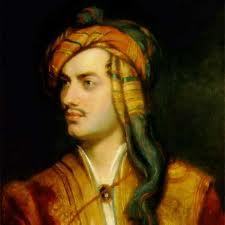 Lord Byron
Lord Byron
During the time I sat by his side he asked many questions about myself and many of our schoolfellows; but on my questioning him in turn about himself, his way of life, and his future plans, he avoided entering into any explanation: indeed, he gave such short and evasive answers, that, thinking my inquisitiveness displeased him, I rose to take my leave. I observed that I had not been lucky enough to see Lord Byron in any of my rambles, to which he replied, "Byron is living at his villa, surrounded by his court of sycophants; but I shall shortly see him at Leghorn." We then shook hands. I never saw him again; for he was drowned shortly afterwards, with his friend, Captain Williams, and his body was washed ashore near Via Reggio. Every one is familiar with the romantic scene which took place on the sea-shore when the remains of my poor friend and Captain Williams were burnt, in the presence of Byron and Trelawney, in the Roman fashion. His ashes were gathered into an urn, and buried in the Protestant cemetery at Rome. He was but twenty-nine years of age at his death.
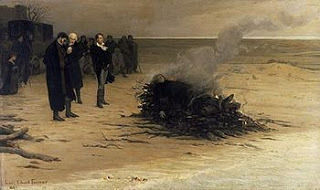 The Funeral of Shelley
The Funeral of Shelley
Notes from Victoria: This painting by Louis Edouard Fournier, completed in 1889 obviously long after the event, shows Edward Trelawney and Byron at the cremation of Shelley's remains on the shore. Also pictured are Mary Shelley, second wife of Percy, kneeling at the far left, and Leigh Hunt, though neither of them actually attended. One of several blue plaques honoring Shelley, the version below can be found at 15, Poland Street, WI, London, between Oxford Circus and Soho Square; Shelley resided here after he left Oxford.
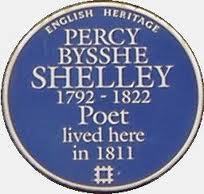
[image error]
 Rees Gronow
Rees GronowSHELLEY
Shelley, the poet, cut off at so early an age; just when his great poetical talents had been matured by study and reflection, and when he probably would have produced some great work, was my friend and associate at Eton. He was a boy of studious and meditative habits, averse to all games and sports, and a great reader of novels and romances. He was a thin, slight lad, with remarkably lustrous eyes, fine hair, and a very peculiar shrill voice and laugh. His most intimate friend at Eton was a boy named Price, who was considered one of the best classical scholars amongst us. At his tutor, Bethell's, where he lodged, he attempted many mechanical and scientific experiments. By the aid of a common tinker, he contrived to make something like a steam-engine, which, unfortunately, one day suddenly exploded; to the great consternation of the neighbourhood and to the imminent danger of a severe flogging from Dr. Reate.
 Percy Byssche Shelley
Percy Byssche ShelleySoon after leaving school, and about the year 1810, he came, in a state of great distress and difficulty, to Swansea, when we had an opportunity of rendering him a service; but we never could ascertain what had brought him to Wales, though we had reason to suppose it was some mysterious affaire du coeur.
The last time I saw Shelley was at Genoa, in 1822, sitting on the sea-shore, and, when I came upon him, making a true poet's meal of bread and fruit; He at once recognized me, jumped up, and appearing greatly delighted, exclaimed, "Here you see me at my old Eton habits; but instead of the green fields for a couch, I have here the shores of the Mediterranean. It is very grand, and very romantic. I only wish I had some of the excellent brown bread and butter we used to get at Spiers's: but I was never very fastidious in my diet." Then he continued, in a wild and eccentric manner: "Gronow, do you remember the beautiful Martha, the Hebe of Spiers's? She was the loveliest girl I ever saw, and I loved her to distraction."
Shelley was looking careworn and ill; and, as usual, was very carelessly dressed. He had on a large and wide straw hat, his long brown hair, already streaked with grey, flowing in large masses from under it, and presented a wild and strange appearance.
 Lord Byron
Lord ByronDuring the time I sat by his side he asked many questions about myself and many of our schoolfellows; but on my questioning him in turn about himself, his way of life, and his future plans, he avoided entering into any explanation: indeed, he gave such short and evasive answers, that, thinking my inquisitiveness displeased him, I rose to take my leave. I observed that I had not been lucky enough to see Lord Byron in any of my rambles, to which he replied, "Byron is living at his villa, surrounded by his court of sycophants; but I shall shortly see him at Leghorn." We then shook hands. I never saw him again; for he was drowned shortly afterwards, with his friend, Captain Williams, and his body was washed ashore near Via Reggio. Every one is familiar with the romantic scene which took place on the sea-shore when the remains of my poor friend and Captain Williams were burnt, in the presence of Byron and Trelawney, in the Roman fashion. His ashes were gathered into an urn, and buried in the Protestant cemetery at Rome. He was but twenty-nine years of age at his death.
 The Funeral of Shelley
The Funeral of ShelleyNotes from Victoria: This painting by Louis Edouard Fournier, completed in 1889 obviously long after the event, shows Edward Trelawney and Byron at the cremation of Shelley's remains on the shore. Also pictured are Mary Shelley, second wife of Percy, kneeling at the far left, and Leigh Hunt, though neither of them actually attended. One of several blue plaques honoring Shelley, the version below can be found at 15, Poland Street, WI, London, between Oxford Circus and Soho Square; Shelley resided here after he left Oxford.

[image error]
Published on March 13, 2012 01:00
March 11, 2012
A Look at The Look of Love
A guest blog by Jo Manning
 Jo Manning (with Lily)
Jo Manning (with Lily)
The LOOK OF LOVE exhibit has opened in Birmingham, Alabama, at the Birmingham Museum of Art. I was fortunate enough to be there for the opening and the first couple of days of the show, which runs until the end of June. For museum information, click here.
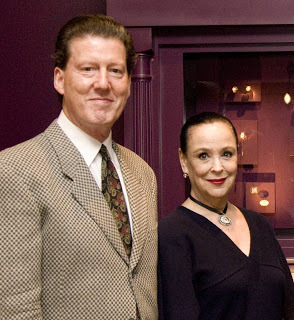 Dr David and Nan Skier
Dr David and Nan Skier
Before discussing this spectacular exhibit – the first of its kind in the world – and one that, with its accompanying catalog, sets the standard for research on this unique portrait miniature-cum-jewelry that has been, up until now, so little known in either the art or jewelry worlds, some backstory…I often tell people that one never knows, after one's book is published and sent out into the marketplace, who will see it, who will be affected by it, and what repercussions it will generate. My biography of Grace Dalrymple Elliott, a notorious courtesan of the late 18th-early 19th centuries, was sold in bookstores and museum gift shops.
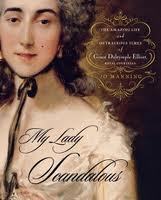
At one of the latter, the Bass Museum of Art's gift shop in Miami Beach, Florida, it was seen by Dr David Skier, an eye surgeon from Birmingham, who thought his wife would enjoy it. One of the things he noticed in the book was a sidebar on Lover's Eyes -- eye miniatures – with a photo of a ring in the "collection of the author".
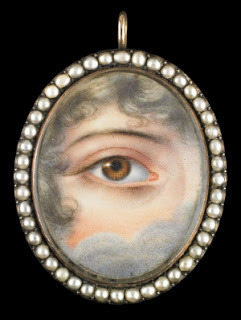
This was of great interest to Dr Skier because he and his wife Nan had quietly been collecting these beautiful objects for many years and had accumulated some 70+ of them. (They now own 100+ of these miniatures.) Assuming that I had a collection of these objects, they wrote to my publisher Simon & Schuster, asking for my contact information. The publisher referred them to my agent, Jenny Bent of the Bent Agency, and she contacted me. I responded promptly with the news that, no, I owned just the one ring, and that I'd become interested in them after seeing the eye miniatures in the collection of my writing colleague Candice Hern, who owned several lovely brooches. I was also entranced by the story of how they came about and their subsequent history.
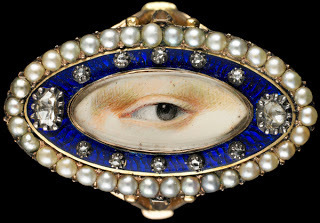
The Skiers became friends, and when I was asked to contribute to the catalog for an exhibition of their collection called The Look of Love, I said I would be happy to do so, but that I did not in any way consider myself an expert on the subject. No, they said, we'd like you to write some stories, vignettes, inspired by the eyes in their collection. I thought this was a brilliant idea, frankly, because each of the eyes had a story – an unknown story for the most part, to be sure, as sitters and artists were mostly unidentified – and the eyes do speak to the viewer. I gave my imagination full rein and wrote five stories for their consideration. To my knowledge, this is another first; I know of no fiction in the catalogs of art shows. Essays on the art and history, yes, those are standard, but bits of fiction…nope! I have to confess that the stories came very easily, which does not always happen to a writer. But the eyes drew me in, and I chose the most eloquent, in my opinion, and wrote away. My goal was to illuminate how these objects of love and affection came about, what they meant in a society with mores quite unlike our own, who the artists might be and why they painted them, what the symbolism involved meant to people in that era, and, yes, the aura they held of clandestine love tokens was very appealing to me, as a writer of historical romance.
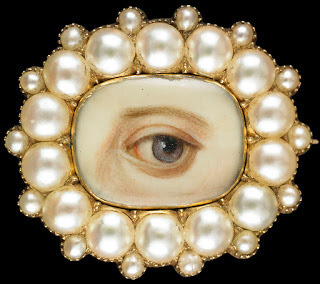
The stories are: "Pippa and William"; "Ursula Engleheart Prepares Tea For Her Artist Husband George…"; "I Mourn Your Loss, My Beloved…"; "My Mother, Mariah Norcross"; and "The Grey Eye in Great-Aunt Lavinia's Jewelry Box". Pippa and William are star-crossed lovers (not to be confused with Pippa Middleton and Prince William J) who meet as children, fall in love, but cannot marry because of dynastic "rules" governing marriage; Ursula Engleheart is the story of a prolific painter of miniatures (an estimated 5,000 of them in his lifetime) who paints eyes for clandestine lovers but doesn't sign them to avoid trouble with his patrons, their parents; I Mourn Your Loss tells a sad tale of two of the many young men who perished in the Napoleonic Wars and how all that remains of one of them is the lover's eye he gave to his fiancée; My Mother, Mariah Norcross is another bereavement story that also illustrates the perils of epidemics in that Georgian era and its horrific costs to families; and, finally, the last story, of what was found in Great-Aunt Lavinia's Jewelry Box by careless heirs, speculates on the possible unfortunate fate of many an eye miniature.
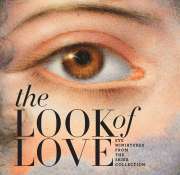
The exhibition, and the beautifully illustrated 208 page catalog – a proper coffee-table book! – have each garnered wonderful publicity. The catalog will probably become a collector's item as well as an important research source on the subject of eye miniatures; the essays by Dr. Graham Boettcher, the curator, and Elle Shushan, a dealer in portrait miniatures, are outstanding, detailed, and most readable.
 Graham Boettcher
Graham Boettcher
 Elle Shushan
Elle Shushan
The exhibit is exquisite, mounted with extreme delicacy and care by the professionals at the Birmingham Museum of Art, and the oohs and ahhs of those visiting the jewel of a room in which it is housed brings joy to everyone who's been involved in its creation and implementation, but most of all to Nan and Dr David Skier, who collected these gorgeous pieces that combine art/history/and jewelry in such a unique manner. Plans are underway to bring the exhibit to other cities; the catalog can be ordered through Amazon, where it has been Number One in its category – Art and Antiques – for weeks. It can also be ordered from the English publisher D Giles Ltd here.
Nan Skier talks about the collection here. Scroll down half a page for the presentation.
There are special events surrounding the Look of Love which can be found on the museum's web site here.
The coverage has been overwhelming: Take a look at the Vanity Fair web article, for example, here.
A beautiful article appears in Antiques & Fine Arts which requires an online FREE registration. Here is the online site: http://www.antiquesandfineart.com/Many other articles area available on the internet and through the museum's website.
A postscript: One of the several delightful people I met – including dealers/art consultants/appraisers Reagan Upshaw, Michael Quick, and Sonja Weber (the book is dedicated to her late husband Barry Weber, who often appeared on Antiques Roadshow) -- was Thomas Sully, a painter and direct descendant of the English-born American painter of the same name.
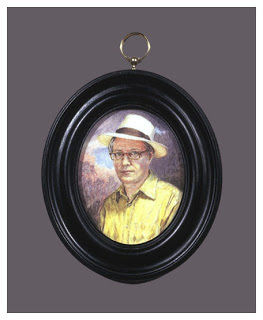 Tom Sully self-portrait miniature
Tom Sully self-portrait miniature
Tom Sully paints portrait miniatures, amongst other painting genres and has lately begun to do eye miniatures. I asked him, "How do you do this? Isn't elephant ivory [which was used for most Georgian eye miniatures] endangered?" He replied that the Russians are selling woolly mammoth – yes! woolly mammoth! – ivory and that is what he is using. Not endangered. Extinct. But not endangered. I saw some samples of his work and it is very fine, indeed. Check him out here.
And do consider commissioning a lover's eye – or two – for yourself.
[image error]
 Jo Manning (with Lily)
Jo Manning (with Lily)The LOOK OF LOVE exhibit has opened in Birmingham, Alabama, at the Birmingham Museum of Art. I was fortunate enough to be there for the opening and the first couple of days of the show, which runs until the end of June. For museum information, click here.
 Dr David and Nan Skier
Dr David and Nan Skier Before discussing this spectacular exhibit – the first of its kind in the world – and one that, with its accompanying catalog, sets the standard for research on this unique portrait miniature-cum-jewelry that has been, up until now, so little known in either the art or jewelry worlds, some backstory…I often tell people that one never knows, after one's book is published and sent out into the marketplace, who will see it, who will be affected by it, and what repercussions it will generate. My biography of Grace Dalrymple Elliott, a notorious courtesan of the late 18th-early 19th centuries, was sold in bookstores and museum gift shops.

At one of the latter, the Bass Museum of Art's gift shop in Miami Beach, Florida, it was seen by Dr David Skier, an eye surgeon from Birmingham, who thought his wife would enjoy it. One of the things he noticed in the book was a sidebar on Lover's Eyes -- eye miniatures – with a photo of a ring in the "collection of the author".

This was of great interest to Dr Skier because he and his wife Nan had quietly been collecting these beautiful objects for many years and had accumulated some 70+ of them. (They now own 100+ of these miniatures.) Assuming that I had a collection of these objects, they wrote to my publisher Simon & Schuster, asking for my contact information. The publisher referred them to my agent, Jenny Bent of the Bent Agency, and she contacted me. I responded promptly with the news that, no, I owned just the one ring, and that I'd become interested in them after seeing the eye miniatures in the collection of my writing colleague Candice Hern, who owned several lovely brooches. I was also entranced by the story of how they came about and their subsequent history.

The Skiers became friends, and when I was asked to contribute to the catalog for an exhibition of their collection called The Look of Love, I said I would be happy to do so, but that I did not in any way consider myself an expert on the subject. No, they said, we'd like you to write some stories, vignettes, inspired by the eyes in their collection. I thought this was a brilliant idea, frankly, because each of the eyes had a story – an unknown story for the most part, to be sure, as sitters and artists were mostly unidentified – and the eyes do speak to the viewer. I gave my imagination full rein and wrote five stories for their consideration. To my knowledge, this is another first; I know of no fiction in the catalogs of art shows. Essays on the art and history, yes, those are standard, but bits of fiction…nope! I have to confess that the stories came very easily, which does not always happen to a writer. But the eyes drew me in, and I chose the most eloquent, in my opinion, and wrote away. My goal was to illuminate how these objects of love and affection came about, what they meant in a society with mores quite unlike our own, who the artists might be and why they painted them, what the symbolism involved meant to people in that era, and, yes, the aura they held of clandestine love tokens was very appealing to me, as a writer of historical romance.

The stories are: "Pippa and William"; "Ursula Engleheart Prepares Tea For Her Artist Husband George…"; "I Mourn Your Loss, My Beloved…"; "My Mother, Mariah Norcross"; and "The Grey Eye in Great-Aunt Lavinia's Jewelry Box". Pippa and William are star-crossed lovers (not to be confused with Pippa Middleton and Prince William J) who meet as children, fall in love, but cannot marry because of dynastic "rules" governing marriage; Ursula Engleheart is the story of a prolific painter of miniatures (an estimated 5,000 of them in his lifetime) who paints eyes for clandestine lovers but doesn't sign them to avoid trouble with his patrons, their parents; I Mourn Your Loss tells a sad tale of two of the many young men who perished in the Napoleonic Wars and how all that remains of one of them is the lover's eye he gave to his fiancée; My Mother, Mariah Norcross is another bereavement story that also illustrates the perils of epidemics in that Georgian era and its horrific costs to families; and, finally, the last story, of what was found in Great-Aunt Lavinia's Jewelry Box by careless heirs, speculates on the possible unfortunate fate of many an eye miniature.

The exhibition, and the beautifully illustrated 208 page catalog – a proper coffee-table book! – have each garnered wonderful publicity. The catalog will probably become a collector's item as well as an important research source on the subject of eye miniatures; the essays by Dr. Graham Boettcher, the curator, and Elle Shushan, a dealer in portrait miniatures, are outstanding, detailed, and most readable.
 Graham Boettcher
Graham Boettcher Elle Shushan
Elle ShushanThe exhibit is exquisite, mounted with extreme delicacy and care by the professionals at the Birmingham Museum of Art, and the oohs and ahhs of those visiting the jewel of a room in which it is housed brings joy to everyone who's been involved in its creation and implementation, but most of all to Nan and Dr David Skier, who collected these gorgeous pieces that combine art/history/and jewelry in such a unique manner. Plans are underway to bring the exhibit to other cities; the catalog can be ordered through Amazon, where it has been Number One in its category – Art and Antiques – for weeks. It can also be ordered from the English publisher D Giles Ltd here.
Nan Skier talks about the collection here. Scroll down half a page for the presentation.
There are special events surrounding the Look of Love which can be found on the museum's web site here.
The coverage has been overwhelming: Take a look at the Vanity Fair web article, for example, here.
A beautiful article appears in Antiques & Fine Arts which requires an online FREE registration. Here is the online site: http://www.antiquesandfineart.com/Many other articles area available on the internet and through the museum's website.
A postscript: One of the several delightful people I met – including dealers/art consultants/appraisers Reagan Upshaw, Michael Quick, and Sonja Weber (the book is dedicated to her late husband Barry Weber, who often appeared on Antiques Roadshow) -- was Thomas Sully, a painter and direct descendant of the English-born American painter of the same name.
 Tom Sully self-portrait miniature
Tom Sully self-portrait miniatureTom Sully paints portrait miniatures, amongst other painting genres and has lately begun to do eye miniatures. I asked him, "How do you do this? Isn't elephant ivory [which was used for most Georgian eye miniatures] endangered?" He replied that the Russians are selling woolly mammoth – yes! woolly mammoth! – ivory and that is what he is using. Not endangered. Extinct. But not endangered. I saw some samples of his work and it is very fine, indeed. Check him out here.
And do consider commissioning a lover's eye – or two – for yourself.
[image error]
Published on March 11, 2012 00:12
March 9, 2012
Best Exotic Marigold Hotel
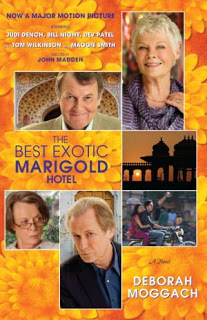
Best Exotic Marigold Hotel, the movie, opens in the UK and Ireland 24 February. Those in the States will have to wait until summer to see the film, although the novel will be available in stores in March.
The movie, directed by John Madden, sees a group of retirement age Brits move to India to see out their elderly years in colorful Jaipur and take up residence in what they believe is a newly restored hotel. Less luxurious than its advertisements, the Marigold Hotel nevertheless slowly begins to charm in unexpected ways. Dev Patel, of "Slumdog Millionaire" fame, plays the guy who entices them to take the adventure and the film also features Dame Judi Dench, Dame Maggie Smith, Penelope Wilton and Bill Nighy.
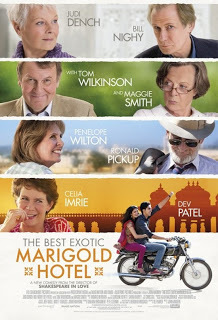
Deborah Moggach is the author of sixteen successful novels, including the bestselling Tulip Fever, and two collections of stories. The book on which this film is based was originally titled These Foolish Things. Her screenplays include Pride and Prejudice, which was nominated for a BAFTA. She lives in North London.
You can watch the movie trailer here.
Published on March 09, 2012 00:06
Kristine Hughes's Blog
- Kristine Hughes's profile
- 6 followers
Kristine Hughes isn't a Goodreads Author
(yet),
but they
do have a blog,
so here are some recent posts imported from
their feed.



